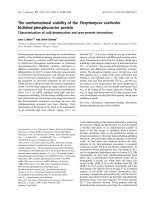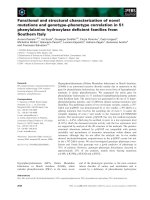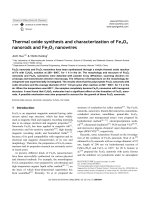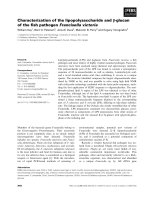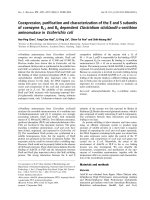Characterization of effective antioxidant components of tropical fruit and vegetable species
Bạn đang xem bản rút gọn của tài liệu. Xem và tải ngay bản đầy đủ của tài liệu tại đây (1.31 MB, 238 trang )
CHARACTERIZATION OF EFFECTIVE ANTIOXIDANT
COMOPNENTS OF TROPICAL FRUIT AND VEGETABLE
SPECIES
SHUI GUANGHOU
(B. E)
NATIONAL UNIVERSITY OF SINGAPORE
2004
CHARACTERIZATION OF EFFECTIVE ANTIOXIDANT
COMOPNENTS OF TROPICAL FRUIT AND VEGETABLE
SPECIES
SHUI GUANGHOU
(B. E)
A THESIS SUBMITTED FOR THE DEGREE OF DOCTOR OF
PHILOSOPHY
FOOD SCIENCE AND TECHNOLGY PROGRAMME
DEPARTMENT OF CHEMISTRY
NATIONAL UNIVERSITY OF SINGAPORE
2004
I
ACKNOWLEDGEMENTS
This thesis would not have been completed without the help of many people.
First and foremost, I would especially like to thank my supervisor, Dr. Leong Lai Peng, for
her consistent support, her patient guidance and her valuable advice throughout the whole
project. I am indebted to her for encouraging me to undertake the challenges and overcome
all the difficulties during the study of this project and for guiding these experiments from
their beginning, and for her suggestions, corrections and help in bringing this thesis to
completion.
I am very grateful to A/P Philip J Barlow, for strong supports and valuable suggestions in my
research progress and other academic activities, Professor Fereidoon Shahidi for his valuable
suggestions at the beginning of this project. I am also deeply grateful to A/P Zhou Weibiao, A/P
Conrad Perera and all other friends and colleagues in the FST programme for their encouragement
and help in enhancing the completion of this project.
I appreciate the great help from Madam Lee Chooi Lan and other FST technical staff for their
numerous acts of help in solving day to day laboratory problems. I am taking this opportunity to
thank Madam Wong Lai Kwan and Ms Lai Hui Ngee for their continuous assistance in mass
spectrometry analysis during the last three years. I would also like to thank all the undergraduates
who were involved in related projects, especially Mr. Wong Shih Peng and Ms. Juli Effendy for
their collaboration and hard work.
II
I am grateful to the National University of Singapore which provided me research scholarship and
research funds to let me have this opportunity to complete this research study. I thank International
Union of Food Science and Technology which awarded me a travel scholarship (about US$ 2,000)
to attend its 12
th
Congress held at Chicago. I also thank Society for Free Radical and Biology
Medicine for its travel awarded (US$ 1,000) during its 10th annual meeting held in Seattle.
Last but not least, I am always grateful to my family, for their substantial support with their endless
love and caring, advice and encouragement in my life. Especially I appreciated my wife Zhou Dan
for her endless support. I could not complete this project in time without her strong support. I am
also indebted to my son for allowing me to spend less time with him than I should have in order for
me to complete this work.
III
TABLE OF CONTENTS
ACKNOWLEDGEMENTS………………………………………………………… …I
TABLE OF CONTENTS……………………………………………………………… III
SUMMARY………………….………………………………………………………… IV
LIST OF TABLES…………………………………………………………………… XII
LIST OF FIGURES………………………………………………………………… XIII
ABBREVIATIONS….……………………………………………………………… XVII
LIST OF PUBLICATIONS………………………………………………………… XIX
APPENDIX I………………………………………………………………………… XXIII
TABLE OF CONTENTS
PART I INTRODUCTION AND LITERATURE REVIEW 1
1 INTRODUCTION…………………………………………………………….… 2
1.1 Benefits of consuming fruits and vegetables ……………………………………… 2
1.2 Free radical damages…………………………………………………………… 3
1.3 Antioxidant protections………………………………………………………… 5
1.4 Antioxidants in fruits and vegetable…………………………………………… 10
1.5 Methods of assessing total antioxidant capacity (TAC) ……………………… 12
1.5.1 TAC by non-inhibition assay………………………………………………… 13
1.5.2 TAC by inhibition methods…………………………………………………… 17
1.5.3 Total phenolic contents (TPC) ……………………… ……………………… 20
1.6 Identification of antioxidants in fruits and vegetables ….……………………… 21
IV
1.6.1 Analysis of antioxidants in fruits and vegetables using HPLC/DAD…… …… 23
1.6.2 Analysis of antioxidants in fruits and vegetables using HPLC/MS ……… … 24
1.7 Aims and objectivity of this study……………………………………………… 25
1.7.1 Study on antioxidant capacity of fruits and vegetables in the Singapore market ……… 25
1.7.2 Identification of major antioxidants of selected fruits and vegetables ……… 27
References……………………………………………………………………… 29
PART II EXPERIMENTAL……………………………………………………… 38
2 MATERIALS AND METHODS…………………………………………………… 39
2.1 Investigation on TAC and TPC of fruits and vegetables …………………… 39
2.1.1 Materials……………………………………………………………………… 39
2.1.2 Sample preparation……………………………………………………………… 40
2.1.3 Methods for TAC and TPC assays……………………………………………… 41
2.1.3.1 ABTS·
+
scavenging assay…………………………………………… 41
2.1.3.2 DPPH· scavenging assay…………………………………………………… 42
2.1.3.3 Ferric reducing/antioxidant power (FRAP) assay ………………………………43
2.1.3.4 Determination of total phenolic contents…………………………… 43
2.2 Measurement of the apparent stoichiometry of pure antioxidants with
ABTS·
+
and DPPH·…………………………………………………………………….44
2.3 HPLC/DAD analysis of antioxidants ……………………………………… 45
2.3.1 Rapid analysis of L-ascorbic acid of fruits and vegetables by HPLC/DAD……… 45
2.3.2 Simultaneous analysis of organic acid and phenolic compounds ….…… 46
2.4 Analysis of antioxidants in selected fruits and vegetables…………………… 48
2.4.1 Analysis of antioxidants in star fruit…………………………………………………48
V
2.4.1.1 Solvent extraction of antioxidants……………………………………………….48
2.4.1.2 Solid phase extraction of antioxidants………………………………………… 49
2.4.1.3 Analysis of antioxidant peak in star fruit using HPLC/DAD ………………… 50
2.4.1.4 ESI-MS and HPLC-DAD-ESI-MS analyses of antioxidants………… 50
2.4.1.5 Anti-rancidity properties of residue extract on soya bean oil………………… 52
2.4.2 Analysis of antioxidants of Lady’s finger………………………………………… 52
2.4.2.1 Solvent extraction of antioxidants…………………………………… 52
2.4.2.2 Solid phase extraction of antioxidants………………………………………… 53
2.4.2.3 HPLC characterization of major antioxidant peaks…………………………… 53
2.4.2.4 HPLC-DAD-ESI-MS
n
analysis of antioxidants of Lady’s finger……………….54
2.4.2.5 Isolation of pure compounds by semi-preparative HPLC……………………….55
2.4.2.6 Spectroscopy study of isolated compounds…………………………………… 55
2.4.3 Analysis of antioxidants of salak……………………………………………………56
2.4.3.1 Solvent extraction of antioxidants………………………………………………56
2.4.3.2 Identification of antioxidants in salak by HPLC/MS and HPLC/MS/MS……….56
2.4.4 Analysis of antioxidants in ciku king……………………………………………….57
2.4.4.1 Solvent extraction of antioxidants………………………………………………57
2.4.4.2 Identification of antioxidant in ciku king by HPLC/MS and HPLC/MS/MS…… 58
2.4.4.3 Changes of TAC & TPC of ciku king fruit during storage………… ………… 58
2.4.5 Analysis of antioxidants of u
lam raja…………………………………………… 58
2.4.5.1 Solvent extraction of antioxidants………………………………………………58
2.4.5.2 Identification of antioxidants in ulam raja by HPLC/MS and HPLC/MS/MS 59
References………………………………………………………………………………60
VI
PART III RESULTS AND DISCUSSIONS………………………………………………62
3 Antioxidant Properties of Fruits and Vegetables…………………………………… 63
3.1 Introduction…………………………………………………………………… 63
3.2 Antioxidant capacity and antioxidant efficiency…………………………………………63
3.3 Antioxidant components of fruits and vegetables……………………………………… 68
3.3.1 L-Ascorbic acid contribution to TAC of selected fruits and vegetables…………… 68
3.3.2 Total phenolic contents of fruits and vegetables…………………………… 73
3.3.3 Effects of antioxidant components on TAC of fruits and vegetables……………… 74
3.4 Assessing antioxidant capacity of fruits, vegetables and pure antioxidants…………… 76
3.4.1 ABTS
.+
decolorization assay……………………………………………………… 77
3.4.2
DPPH· scavenging assay…………………………………………………………81
3.4.3 Ferric reducing/antioxidant power (FRAP) assay………………………………… 77
3.4.4 Comparison of methods for TAC assays ……………………………………….82
3.5 Chapter summary……………………………………………………………………… 90
References………………………………………………………………………………92
4 Separation of Organic Acids and Phenolic Compounds by High Performance
Liquid Chromatography………………………………………………………………95
4.1 Introduction …………………………………………………………………………….95
4.2 Method development……………………………………………………………………96
4.3 Method validation .……………………………………………………………… … 100
4.4 Analysis of organic acids and phenolic compounds in apple juice Analysis ………… 100
4.5 Negative effects on chromatographic profiles by sample solvents…………… 102
4.6 Chapter summary……………………………………………………………… 104
VII
References…………………………………………………………………………….105
5 Antioxidants in Star fruit (Averrhoa Carambola L.)………….………….…………107
5.1 Introduction …………………………………………………………………… 107
5.2 Solvent extraction of antioxidants…………………………………………….………107
5.3 Distribution of antioxidants in star fruit……………………………………………….110
5.4 Inhibition of lipid peroxidation….…………………………………………………….111
5.5 Correlations between TAC and total phenolic contents……………………………….113
5.6 HPLC-DAD assay of antioxidant components……………………………………… 113
5.7 Identification of antioxidanst by HPLC and mass spectrometry………………… 116
5.8 Comparison of antioxidant capacity and phenolic profile of residue and
Pycnogenol pills…………………………………………………………… ……….127
5.9 Chapter summary… ……………………………………………………………… 130
References ………………………………………………………………….……….132
6 Antioxidants in Lady’s Finger (Hibiscus Esculentus Linn)……….……….……… 135
6.1 Introduction ……………………………………………………………….……… 135
6.2 Characterisation of major antioxidant peaks in lady’s finger………………….……… 136
6.3 Identification of antioxidants using HPLC/MS
n
…………… …………….…… 140
6.4 Structure confirmation using spectrometric methods……… …………….……….145
6.5 Chapter summary………………………………………………………….……… 149
References…………………………………………………………………….……….150
7 Antioxidants in Salak (Salacca Edulis Reinw)……………………………….…… 152
7.1 Introduction …………………………………………………………………….…… 152
7.2 Free radical active components in salak extract ……………………………………… 155
VIII
7.3 Identification of antioxidants using HPLC/MS
n
………………………… …… …….159
7.4 Reactivity of antioxidants with free radicals…………………….…………………… 163
7.5 Chapter summary…………………………………………………………………… 164
References…………………………………………………………………… 165
8 Antioxidants in Ciku King (Manilkara Zapota)….………………………………….167
8.1 Introduction ………………………………………………………………………… 167
8.2 Changes of TAC & TPC during storage……………………………………………….168
8.3 Identification of antioxidants in ciku king using HPLC/MS
n
……………. …………….171
8.4 Chapter summary…………………………………………………………………… 186
References………………………………………………………………………… …187
9 Antioxidant in Ulam Raja(Cosmos caudatus)……….…………………………… 188
9.1 Introduction ……………….……………………………………………………… ….188
9.2 Free radical active components in ulam raja…………………………………….… … 189
9.3 Identification of antioxidants in ulam raja using HPLC/MS
n
……………… 197
9.4 Chapter summary……………………………………………………………….… ….203
References…………………………………………………………………….….…….204
PART IV CONCLUSIONS AND FUTURE WORKS…… ………………………… 205
10 Conclusions …………………………………………………………………….… 206
10.1 Future work………………………………………………………………………… 210
IX
SUMMARY
This research project has investigated the potential for tropical fruits and vegetables as sources of
natural antioxidants in the diet. Several in vitro methods i.e. 2,2’-Azino-bis-(3-
ethylbenzothiazoline-6-sulfonic acid) free radical (ABTS·
+
), 1,1-Diphenyl-2-picrylhydrazyl
(DPPH·) and ferric reducing antioxidant power (FRAP) were employed and compared for
determination of total antioxidant capacity (TAC) of selected fruits and vegetables obtained from
the Singapore market. Investigation of total antioxidant capacity of a variety of fruits and vegetables
confirmed that most fruits and vegetables are good sources of natural antioxidants. The L-ascorbic
acid contribution to TAC of fruits and vegetables varied greatly among species, from 0.06% in ciku
to 70.2% in rambutan. Other than L-ascorbic acid, a variety of phenolic compounds were found to
be major antioxidants in most fruits and vegetables, especially in those products with high or
extremely high antioxidant capacity.
A range of common Southeast Asian fruits and vegetables including ciku (Manilkara zapota), ciku
king (Manilkara zapota), ulam raja (Cosmos caudatus), salak (Salacca spp), star fruit (Averrhoa
carambola L.) and lady’s finger (Hibiscus esculentus), were found to be excellent sources of natural
antioxidants. The chemical structures of antioxidant compounds of selected products were
systematically investigated using high performance liquid chromatography (HPLC) coupled with
diode array detection, high performance liquid chromatography coupled with mass spectrometry
(HPLC/MS) and nuclear magnetic resonance (NMR) spectroscopy.
X
A new HPLC method was developed for the separation and identification of antioxidants varying
from very polar compounds such as L-ascorbic acid to moderately polar compounds e.g. flavonoid
aglycones in extracts. The method is simple and straight forward to carry out as no additional
sample pretreatment is required.
To characterise major antioxidants in star fruit, a new approach was developed. HPLC coupled with
a diode array detector (DAD) was used to characterise antioxidant peaks in the juice or solvent
extract through spiking with free radicals. By analysing the antioxidant capacity and
chromatograms of fractions from solid phase extraction, it was possible to characterize the main
antioxidant products. The antioxidants in star fruit included L-ascorbic acid, (-)epicatechin and
proanthocyanidins which exist as dimers through hexamers. The presence of (-)epicatechin and
proanthocyanidins are reported in star fruit for the first time and are preliminarily considered as the
major phenolic compounds in star fruit.
Using an improved approach from the above, the major antioxidants of aqueous ethanol extract
from Lady’s Finger (Hibiscus esculentus Linn) were systematically investigated. The improved
approach uses ABTS
+
• prepared from oxidation of ABTS with MnO
2
to characterize antioxidant
peaks, and thus reduce interferences of peaks from ABTS
+
• oxidized by potassium persulphate.
The improved approach was successfully used for identification of major antioxidants in Lady’s
finger. The major antioxidants in Lady’s Finger were identified to be (-)-epigallocatechin and
quercetin derivatives.
XI
Another new approach was also developed for the rapid screening and identification of antioxidants
in biological samples. This new approach was based on a significant decrease in the intensity of ion
peaks obtained from high performance liquid chromatography (HPLC) coupled with mass
spectrometry (MS) following reaction with ABTS
+
•. HPLC/MS/MS was further applied to
elucidate the structure of antioxidant peaks characterized in the spiking test. The new approach was
successfully applied for the identification of antioxidants in extracts of salak, ciku and ulam raja.
The antioxidants in salak were identified as chlorogenic acid, (-)-epicatechin, singly-linked
proanthocyanidins that mainly existed as dimers through hexamers of catechin or epicatechin. The
possible chemical structure of 24 antioxidants in extract of ciku king fruit were also elucidated
using HPLC coupled with tandem mass spectrometry. Polyphenolics with basic blocks of
gallocatechin or catechin or both were found to widely exist in the extract of ciku king fruit and
preliminarily considered as its major antioxidants. Similarly, the chemical structures of 28
antioxidants in extract of ulam raja were elucidated using HPLC coupled with tandem mass
spectrometry. The major antioxidants in ulam raja were attributed to be a number of
proanthocyanidins, quercetin glycosides, chlorogenic acid and its isomers.
XII
LIST OF TABLES
Table 1.1 Classes of phenolics
Table 2.1 Concentration of antioxidant standards
Table 3.1 AEAC of selected fruits and vegetables using ABTS·
+
assay and their L-ascorbic
acid content
Table 3.2 TAC and total phenolics of selected fruits and vegetables
Table 3.3 No. of mol of free radicals reduced by every mol of antioxidants
Table 4.1 Linearity range and limit of detection of carboxylic acid and phenolic compounds
Table 5.1 Antioxidant contribution in processed star fruit solution
Table 5.2 AEAC of star fruit at different extraction conditions
Table 5.3 Positive and negative ions of major antioxidant peaks
Table 5.4 Comparisons of elution times of proanthocyanidins in pycnogenol and star fruit
Table 6.1. Antioxidant activity performance of fractions.
Table 6.2 ESI-MS
n
spectra of compounds 1~5
Table 6.3
13
C NMR spectral data of compounds 1–4 in DMSO-d
6
(δ: ppm)
Table 7.1 Ion peak intensities of extract and its reaction solution with ABTS·
+
Table 7. 2 Positive and negative ions and their corresponding CID ions of antioxidants
Table 8.1 Positive and negative ions and corresponding CID ions of some antioxidants
Table 9.1 Positive and negative ions and their corresponding CID ions of antioxidants
XIII
LIST OF FIGURES
Fig. 1.1 Pathways for the oxidation and regeneration of vitamin E
Fig. 1.2 Chemical structures of ABTS and its free radical
Fig. 1.3 TAC by ABTS·
+
or DPPH· assay
Fig. 1.4 The structure of DPPH radical
Fig. 1.5 ABTS·
+
inhibition assay.
Fig. 3.1 AEAC values at different reaction time
Fig.3. 2. Comparison of reactions between pyrogallol and L-ascorbic acid with ABTS•
+
Fig. 3.3 Correlation of AEAC and total phenolic content among fruits and vegetables
Fig. 3.4 Reaction of ABTS•
+
and chlorogenic acid
Fig. 3.5 Kinetic curve of change of absorbance upon addition of fruit extracts
Fig. 3.6 Decrease in absorbance at 414 nm upon addition of L-ascorbic acid
Fig. 3.7 Plot of loss in absorbance against corresponding L-ascorbic acid (AA) concentrations
(R
2
=0.9956)
Fig. 3.8 The effects of concentration of AA on DPPH
.
decolorization (R2=0.9883)
Fig. 3.9 Standard calibration curve: [Fe(II)] vs A
593
(R
2
=0.9893)
Fig. 3.10 Correlation of change of absorbance in TAC assays and change of absorbance in
TPC assay
Fig. 3.11 Correlation of FRAP value and AEAC by DPPH· model (R
2
=0.8544)
Fig. 3.12 Correlation of FRAP value and AEAC by ABTS·
+
method (R
2
=0.9301)
Fig. 3.13 AEAC values of fruits and vegetables by ABTS·
+
and DPPH· methods
Fig. 3.14 Stoichiometry coefficient of antioxidants with by ABTS·
+
and DPPH· methods
Fig. 4.1 HPLC of the mixture of standards.
XIV
Fig. 4.2 Chromatogram of Berry apple juice showing carboxylic acid and phenolic compounds
profiles: 2 (A), 0-30 min; 2 (B), 30-80 min.
Fig. 4.3 Negative effects on chromatographic profile by methanol: 5 (A): Standards dissolved in
methanol/water (25/75, v/v) (B): Standards dissolved in water.
Fig. 5.1 Extraction efficiency vs solvent percentage Extraction temperature: 90 °C; extraction time:
45minutes
Fig. 5.2 ∆A
414 nm
vs extraction temperature. Extraction time: 45 min; solvent, 50% acetone
solution
Fig. 5.3 ∆A
414 nm
vs extraction time. Extraction temperature, 90 °C; solvents: 50% acetone solution
Fig. 5.4 Effects of BHT and residue extract on peroxidation of Soya bean oil
Fig. 5.5 Correlations between loss of absorbance change and total phenolic contents
Fig. 5.6 Chromatograms of free radical spiking test. (a): solid line, Chromatogram of juice with
water; dashed line, Chromatogram of ABTS·
+
with water; (b): Chromatogram of reaction solution
of juice and ABTS·
+
.
Fig. 5.7 Chemical structure of main proanthocyanidins in pycnogenol
Fig. 5.8 CID (MS/MS Scan) spectrum at m/z 291 of (-)epicatechin, collision energy: 35%.
Fig. 5.9 CID (MS/MS Scan) spectra of Pycnogenol proanthocyanidins, collision energy: 50%. (a)
Corresponding to the parent ion(s) at m/z 579; (b) corresponding to the parent ion(s) at m/z 867.
Fig. 5.10 Fragmentation patterns of B-type proanthocyanidin
Fig. 5.11 HPLC-DAD-ESI-MS analysis of residue extract. (a): Chromatogram at 280 nm; (b): TIC
at positive mode. Ion traces of (c) to (g) corresponding to monomers (m/z 291), dimers (m/z 579),
trimers (m/z 867), tetramers (m/z 1155) and pentamers (m/z 1443), respectively.
Fig. 5.12 CID (MS/MS Scan) spectra of antioxidant peaks in residue extract, collision energy: 50%.
CID spectrum corresponding to the parent ion(s) at m/z 579; (b) CID spectrum corresponding to the
parent ion(s) at m/z 867; (c) CID spectrum corresponding to the parent ion(s) at m/z 1155; (d) CID
spectrum corresponding to the parent ion(s) at m/z 1443.
Fig. 5.13 Ion traces of proanthocyanidins in pycnogenol and star fruit. (a) Ion traces of monomers
through heptamers in pycnogenol. (b) Ion traces of monomers through heptamers in star fruit.
Fig. 6.1 Chromatograms of ABTS
+
• solution oxidized by potassium persulfate and manganese
dioxide. Solid line, ABTS
+
• oxidized by manganese dioxide; dashed line, ABTS
+
• oxidized by
potassium persulfate.
XV
Fig. 6. 2 Chromatograms of extract and reaction solution of extract and ABTS
+
•. Solid line, 1:5 of
extract/ ABTS
+
• (v/v); dashed line, 1:5 of extract/0.1% formic acid (v/v). Detection wavelength:
280 nm.
Fig. 6. 3 Chromatograms of extract and FRCs. (a), 1:3 of extract/0.1% formic acid; (b), FRC 1; (c),
1:1 of FRC 2/0.1% formic acid; (d), FRC 3. Detection wavelength: 280 nm.
Fig. 6.4 ESI-MS
2
mass spectra of compounds at positive mode. (a) CID spectrum corresponds to
the positive parent ion(s) at m/z 597 (MS/MS Scan), collision energy: 50%; (b) CID spectrum
corresponds to the positive parent ion(s) at m/z 551 (MS/MS Scan), collision energy: 50%. CID
spectra at m/z 627 and 465 are similar to those at m/z 597 and 551 respectively.
Fig. 6.5 ESI-MS
n
mass spectra of compounds 4 at negative mode. (a) CID spectrum corresponds to
the negative parent ion(s) at m/z 549 (MS/MS Scan), collision energy: 80%. (b) CID spectrum
corresponds to the negative parent ion(s) at m/z 505 from m/z 549 (MS
3
), collision energy: 80%.
Fig. 6.6 Chemical structures of compounds 1-4
Fig. 7.1 HPLC Chromatograms of salak extract. (a) 280 nm; (b) TIC at positive mode; (c) TIC at
negative mode.
Fig. 7.2 ESI-MS profiles of extract and reaction solution at stage 2 (10-20 min) under negative
modes. (a) Extract:water=1:2; (b) Extract: ABTS·
+
=1:2
Fig. 7.3 Extracted ion chromatograms for possible antioxidant ion peaks
Fig. 7.4 Chemical structures of proanthocyanidins in salak extract (n=1-6)
Fig. 7.5 Kinetics of ABTS·
+
with (-)epicatechin and chlorogenic acid. Reaction conditions: room
temperature (~28ºC); 30 µL addition of 3.1 mM of (-)epicatechin and 30 µL addition of 3.3 mM of
chlorogenic acid into 3 mL of 1.0 mM ABTS·
+
solution.
Fig. 8.1 Variation of total antioxidant capacity of ciku king fruits with storage time
Fig. 8.2 Variation of total phenolics content of ciku king fruits with storage time
Fig. 8.3 Correlations between TAC and TPC
Fig. 8.4 ESI/MS profiles of antioxidant elution period (6-19 min). (a) Sample with water; (b)
Sample with ABTS
+
•
Fig. 8.5 Extracted chromatograms of antioxidant ion peaks in ciku king extract.
XVI
Fig. 8.6 ESI-MS/MS mass spectra of gallocatechin dimers through pentamers at positive mode. (a)
CID spectrum corresponds to the positive parent ion(s) at m/z 611 (MS/MS Scan); (b) CID
spectrum corresponds to the positive parent ion(s) at m/z 915 (MS/MS Scan); (c) CID spectrum
corresponds to the positive parent ion(s) at m/z 1219 (MS/MS Scan); (d) CID spectrum corresponds
to the positive parent ion(s) at m/z 1523 (MS/MS Scan). Collision energy, 70%.
Fig. 8.7 Fragmentation patterns of gallocatechin dimer
Fig. 8.8 Chemical structures of prodelphinidins with gallocatechin as basic units in ciku king
extract (n=1-6)
Fig. 8.9 Chemical structures of a dimer constituted of a gallocatechin and a gallocatechin gallate
(Compound C10)
Fig. 9.1 HPLC chromatograms of ulam raja extract with UV and mass spectrometry detectors
respectively.
Fig. 9.2 ESI/MS profiles of elution period 1 (0-10 min). (a) Sample with water; (b) Sample with
ABTS
+
•
Fig. 9.3 ESI/MS profiles of elution period 1 (10-20 min). (a) Sample with water; (b) Sample with
ABTS
+
•
Fig. 9.4 ESI/MS profiles of elution period 1 (20-30 min). (a) Sample with water; (b) Sample with
ABTS
+
•
Fig. 9.5 ESI/MS profiles of elution period 1 (30-40 min). (a) Sample with water; (b) Sample with
ABTS
+
•
Fig. 9.6 Chemical structures of compounds U1-U18 (n=1-6)
Fig. 9.7 CID spectra compounds 19-21 from parent ions at m/z 355. (a), Compound 19. (b),
Compound 20. (c), Compound 21
Fig. 9.8 Chemical structures of compounds 19-21
Fig. 9.9 Chemical structures of some quercetin derivatives
XVII
ABBREVIATIONS
AA L-Ascorbic acid
AAPH 2,2'-Azobis(2-aminopropane) dihydrochloride
ABTS 2,2’-Azino-bis-(3-ethylbenzthiazoline-6-sulfonic acid
AEAC L-Ascorbic acid equivalent antioxidant capacity
AMD Age-related Macular Degeneration
BHA Butylated hydroxyanisole
BHT Butylated hydroxytoluene
CID Collision induced dissociation
DAD Diode array detector
DPPH 1,1-Diphenyl-2-picrylhydrazyl
ESI Electronspray ionisation
FRAP Ferric reducing /antioxidant power
GAE Gallic acid equIvalent
GC Gas chromatography
HPLC High performance liquid chromatography
MS Mass spectrometry
NMR Nuclear magnetic resonance
ORAC Oxygen radical absorbance capacity
RDA Recommended dietary allowance
RDA-F Retro-Diels-Alder fission
RP-HPLC Reverse phase high performance liquid chromatography
ROS Reactive oxygen species
XVIII
RNS Reactive nitrogen species
SPE Solid phase extraction
TLC Thin layer chromatography
TPTZ Tripydyltriazine
TAC Total antioxidant capacity
TPC Total phenolic content
TBHQ tert-Butylhydroquinone
TEAC Trolox equivalent antioxidant capacity
TBARS Thiobarturic acid reactive substances
TRAP Total radical trapping potential
TPC Ttotal phenolic content
TIC Total ion chromatogram
XIX
LIST OF PUBLICATIONS BASED ON THE STUDY
Journal papers (published)
1. G. Shui and L. P. Leong. “Analysis of Polyphenolic Antioxidants in Star Fruit Using High
Performance Liquid Chromatography and Mass spectrometry ”. J. Chromatogr. A. 1022 (2004)
67-75.
2. G. Shui and L. P. Leong. “Rapid characterization and identification of antioxidants of salak
(Salacca edulis reinw) using High Performance Liquid Chromatograph Coupled with Mass
Spectrometry”. Free Radical Biology and Medicine. 35 (2003) sup.1, S47.
3. G. Shui and L. P. Leong. “Separation and Determination of Organic Acids and Phenolic
Compounds of Fruit Juices and Drinks by High-Performance Liquid Chromatography”, J.
Chromatogr. A 977 (2002) 89-96.
4. L. P. Leong and G. Shui. “An Investigation of Antioxidant Capacity of fruits in the
Singapore markets”. Food Chem. 76(2002) 69-75.
Journal papers (submitted or in progress)
1. G. Shui, L. P. Leong and S.P. Wong. “Ulam Raja, a mine of natural antioxidants”. In progress
(2004).
2. G. Shui and L. P. Leong “Residue from Star Fruit Juice Processing Waste as a value-added food
ingredient and its potential as antioxidant nutraceuticals”. In progress(2003) .
3. G. Shui and L. P. Leong. “Rapid characterization and identification of free radical-active
components in biological samples using High Performance Liquid Chromatograph Coupled with
Mass Spectrometry”. In progress (2004).
XX
4. G. Shui, L. P. Leong, Juli Effendy. “A systematic comparison of two reactive nitrogen species
(RNS) scavenging methods for assay of total antioxidant capacity: from apparent stoichiometry to
reactivity”. In progress (2004).
5. G. Shui; S.P. Wong; L.P. Leong. “Identification of antioxidants in Chiku king (Achras sapota
Linn.) using HPLC/ESI/MS and Changes of its antioxidant capacity and total phenolics during
natural ripening”. In progress (2004).
6. G. Shui and L. P. Leong. “Antioxidant Capacity, Antioxidant Efficiency and Major Antioxidants
of Some Fruits and Vegetables”. In progress (2004).
7. G. Shui and L. P. Leong “Analysis of Major Antioxidants of Aqueous Ethanol Extract from
Hibiscus esculentus Linn Using High Performance Liquid Chromatography Coupled with Tandem
Mass Spectrometry and Confirmation of Structures Using Nuclear Magnetic Resonance”. In
progress (2004). .
Conference papers
1. G. Shui; S.P. Wong; L.P. Leong. (2004). “Identification of antioxidants and changes of
antioxidant levels during storages of Achras sapota Linn.”. Singapore International Chemical
Conference 3: Frontiers in Physical and Analytical Chemistry, p131. Singapore
2. G. Shui; L.P. Leong. (2004) “A new approach for Identification of Major Antioxidants in
Biological Samples”. Singapore International Chemical Conference 3: Frontiers in
Physical and Analytical Chemistry, P85. Singapore
3. G. Shui; L.P. Leong. (2004) “Rapid Screening and identification of antioxidants in salak
(Salacca edulis reinw) using High Performance Liquid Chromatograph Coupled with Mass”.
The 10
th
SFRBM Annual Meeting, Seattle, USA.
XXI
4. G. Shui; L.P. Leong. (2004) “A systematic comparison of two reactive nitrogen species
(RNS) scavenging methods for assay of total antioxidant capacity: from real stoichiometry to
kinetic reaction type”. The 2
nd
Asia-Pacific Conference and Exhibition on Anti-Aging
Medicine, p22. Singapore.
5. G. Shui and L. P. Leong (2003) “A New Approach for Characterization of Major Antioxidative
Components in Fruits and Vegetables and Its Application on Identification of Polyphenolics in
Lady´s Finger (Hibiscus esculentus Linn )”. The 12
th
World Food Congress, Chicago.
6. Guanghou Shui, Shih Peng Wong, Lai Peng Leong. “Ciku king (Achras sapota Linn), Super
Resource of Antioxidants, but When to Eat?”. The 8th ASEAN Food Conference, 2003. Hanoi,
Vietnam.
7. G. Shui; L.P. Leong. (2003). “Antioxidative Properties and Major Antioxidants of Fruits and
Vegetables”. HAS-NUS Joint Scientific Seminar: Collaborative Research in Health Sciences.
Singapore.
8. G. Shui and L. P. Leong (2002). “Antioxidative Properties of Star Fruit”. Third
International Conference and Exhibition on Nutraceuticals and Functional Foods. San
Diego, USA.
9. G. Shui, L.P Leong. (2002) “Antioxidants of Star fruit”. The Asia-Pacific Conference
and Exhibition on Anti-Aging Medicine, p14. Singapore.
10. L.P Leong., G. Shui (2001) “Total Antioxidant Capacity and L-Ascorbic Acid Content of
Fruits”. International Conference on Fundamental Sciences: Biological and Chemical
Sciences, Singapore
XXII
11. L.P Leong., G. Shui (2000) “A New Approach to Predict the Kinetic of Antioxidative products
Formed in the Maillard Reaction”. First International Conference and Exhibition on
Nutraceuticals and Functional Foods. Houston, USA.
1
PART I
INTRODUCTION & LITERATURE REVIEW
